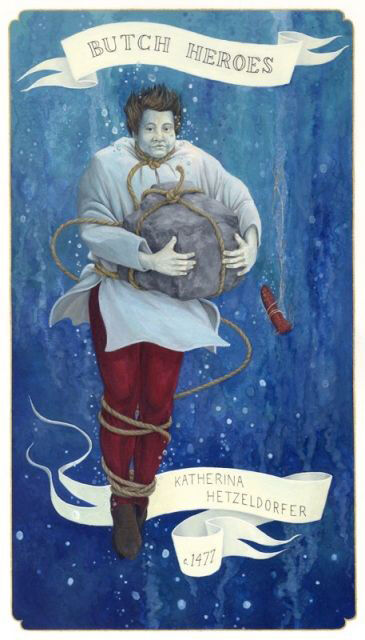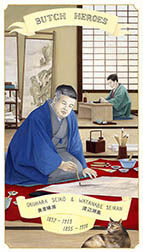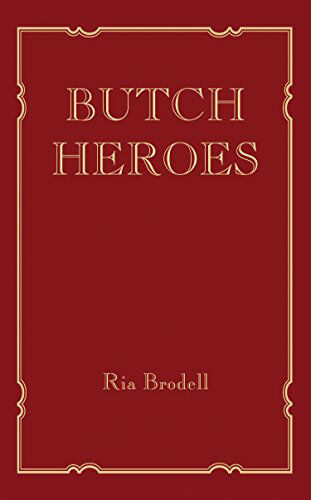Im Rahmen der Vienna Art Week zeigt Bernhard Cella im Salon für Kunstbuch Arbeiten der US-amerikanischen Künstlerin Ria Brodell. Um das Heroische im Vergessenen zu finden, recherchierte Brodell für jedes der achtundzwanzig Porträts ein Leben aus historischen Berichten, Karten, Journalen, Gemälden, Zeichnungen und Fotografien zusammen.

Salon für Kunstbuch
Luftbadgasse 16
1060 Wien
Im Rahmen der Vienna Art Week zeigt Bernhard Cella im Salon für Kunstbuch Arbeiten der US-amerikanischen Künstlerin Ria Brodell.
Um das Heroische im Vergessenen zu finden, recherchierte Brodell für jedes der achtundzwanzig Porträts ein Leben aus historischen Berichten, Karten, Journalen, Gemälden, Zeichnungen und Fotografien zusammen. Dies sind nur drei der Leben, die für ihre queere Geschichte erforscht wurden: Katherina Hetzeldorfer, verstorben 1477, verurteilt aufgrund eines "Verbrechens, das keinen Namen hatte“; Charles alias Mary Hamilton aus dem England des 18. Jahrhunderts, für schuldig befunden, sich als Mann ausgegeben zu haben; Clara, auch bekannt als „Big Ben“, um den 1926 zwei eifersüchtige Frauen in New York kämpften.
Porträts und Texte stellen die verlorene queere Geschichte wieder her: das Leben von Menschen, die sich vom fünfzehnten bis zum zwanzigsten Jahrhundert nicht an Geschlechtsnormen orientierten.
Artist Statement: Butch Heroes
I started this project in 2010 after making the painting Self Portrait as a Nun or Monk, circa 1250. I was thinking about what my life would have been like had I been born into a different century. Joining the church, becoming a nun or a monk, was one option for those who did not want to enter into a heterosexual marriage or conform to the strict gender roles of their time. As a former Catholic, I knew that “homosexuals” were called to a lifetime of chastity or service to the church, but I supposed that queer people of the past must have found other ways to live, and I wanted to find out how they did so.
I started by going to the LGBTQIA sections of local libraries, including Boston Public Library and the libraries at Tufts University and Boston College, and scouring books on our history for names and stories. Finding the names of actual individuals, as opposed to just generalized stories or legends, is the most difficult part of such research. It requires reading between the lines because so much of queer history has been explained away as illness, romantic friendship, opportunistic cross-dressing, or fraud, or is rewritten or censored to suit the time period.
For this project, I was looking for people in history with whom I can personally identify—people who were assigned female at birth, had documented relationships with women, and whose gender presentation was more masculine than feminine. I searched for people from diverse ethnic, societal, and geographic backgrounds, and who were born before or around the turn of the twentieth century.
Some of my subjects identified as women, others as men; some shifted between gender presentations throughout their lives, while others embodied both simultaneously. I use the narratives of their lives to establish their place in this project. Though some could be identified today with the terms “lesbian,” “transgender,” “nonbinary,” “genderqueer,” etc., these myriad LGBTQIA terms were not available to them during their lifetimes. Since it is impossible to know exactly how each person would self-identify using today’s terminology, I view this project as an ongoing effort to document a shared history within the LGBTQIA community.
I include each person’s chosen name(s) and given name for historical accuracy and to aid in research purposes. To determine pronoun use, I refer to their gender presentation or chosen name at each point in their story. If it is uncertain, I use “she or he,” “him/her,” “they,” or just their name(s).
Once I found a name and a story that interested me, I tried to get access to the original source, which might be a newspaper article or a personal journal entry, for example. I looked for anything that included the subject’s own voice, and hopefully a description of them. I tried to find other sources to verify the information. I summarize their stories here and include my sources so that others can access the original material. Each portrait involved extensive research into all aspects of the person’s life, social class, occupation, clothing, and environment. I strove to be historically accurate and culturally sensitive to each individual.
Each painting was a new challenge and a different journey into history. I used descriptive accounts and other sources, such as artifacts, maps, journals, paintings, drawings, prints, or photos from the time period to help me create a real or imagined portrait of the subject. Figuring out how to represent aspects of their lives visually was the best part. For example, I’ve been in the basement of the Cabot Science Library at Harvard, handling and taking notes from one of Olga Tsuberbiller’s dusty textbooks; I scoured old maps of Stockholm trying to determine what the skyline would have looked like from the Haymarket in 1679; I examined buffalo robes from the National Museum of the American Indian and at the Peabody Essex Museum; and I watched YouTube videos of a father and son team (with thick Scottish accents) demonstrating how to properly plaster a traditional Scottish house for John Oliver’s portrait. I loved gathering the details.
Using the format of the Catholic holy card was a personal and logical stylistic choice for me. I still have a collection of holy cards that belonged to my late aunt. I loved going through the collection with her and hearing her tell the stories of the saints. They are beautiful, intimate objects. They’re also handed out at funerals to help honor deceased family members, used to commemorate special events, or even just exchanged between friends and family as kindly gestures. When I was a child the saints depicted on the holy cards were presented to me as role models. They are figures from church history that are revered, one is meant to look to them for guidance or to help find peace. For me, this format is a perfect (subversive) way to present the lives of people who were long forgotten and abused during their lifetime, especially because so many of them were accused of “mocking God and His order” or deceiving their fellow Christians.
Finally, I have chosen the term “Butch” for my title because of its dual nature: it has been slung as an insult and used as a congratulatory recognition of strength. It has a history within the LGBTQIA community and is familiar to the cisgender, heterosexual community. In addition to the term’s traditional associations of being masculine in appearance or actions, I chose to use “Butch Heroes” to indicate people who were strong or brave in the way they lived their lives and challenged their societies’ strict gender roles.
Bernhard Cella is interested in the economic and sculptural framework in which artists’ books – highly informed objects in themselves – can be used as artistic materials. To this end, he conceptualized the ’Salon für Kunstbuch’, a life-size model of a bookshop, in his studio in Vienna. Since 2007, more than 12.000 artists' books have accumulated and entered into unfamiliar vicinities and dialogues. Buying and selling these objects become an integral part of an original artistic practice. www.salon-fuer-kunstbuch.at, www.cella.at.
Ria Brodell: Buch Heroes,
MIT Press, Hardcover, 96 Seiten, 28 Farbtafeln, Oktober 2018
€ 25.00.- bestellen




